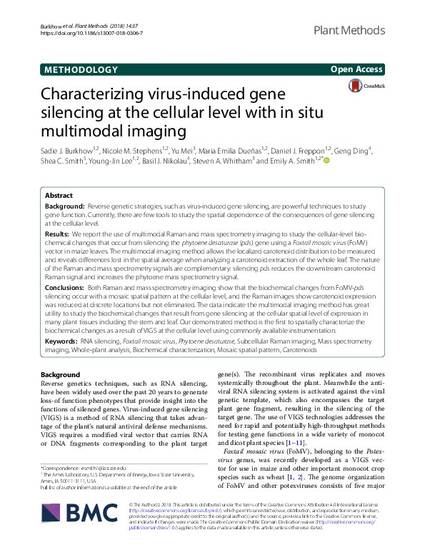
Background: Reverse genetic strategies, such as virus-induced gene silencing, are powerful techniques to study gene function. Currently, there are few tools to study the spatial dependence of the consequences of gene silencing at the cellular level.
Results: We report the use of multimodal Raman and mass spectrometry imaging to study the cellular-level biochemical changes that occur from silencing the phytoene desaturase (pds) gene using a Foxtail mosaic virus (FoMV) vector in maize leaves. The multimodal imaging method allows the localized carotenoid distribution to be measured and reveals differences lost in the spatial average when analyzing a carotenoid extraction of the whole leaf. The nature of the Raman and mass spectrometry signals are complementary: silencing pds reduces the downstream carotenoid Raman signal and increases the phytoene mass spectrometry signal.
Conclusions: Both Raman and mass spectrometry imaging show that the biochemical changes from FoMV-pds silencing occur with a mosaic spatial pattern at the cellular level, and the Raman images show carotenoid expression was reduced at discrete locations but not eliminated. The data indicate the multimodal imaging method has great utility to study the biochemical changes that result from gene silencing at the cellular spatial level of expression in many plant tissues including the stem and leaf. Our demonstrated method is the first to spatially characterize the biochemical changes as a result of VIGS at the cellular level using commonly available instrumentation.
Available at: http://works.bepress.com/steven-whitham/40/

This article is published as Burkhow, Sadie J., Nicole M. Stephens, Yu Mei, Maria Emilia Dueñas, Daniel J. Freppon, Geng Ding, Shea C. Smith et al. "Characterizing virus-induced gene silencing at the cellular level with in situ multimodal imaging." Plant Methods 14, no. 1 (2018): 37.